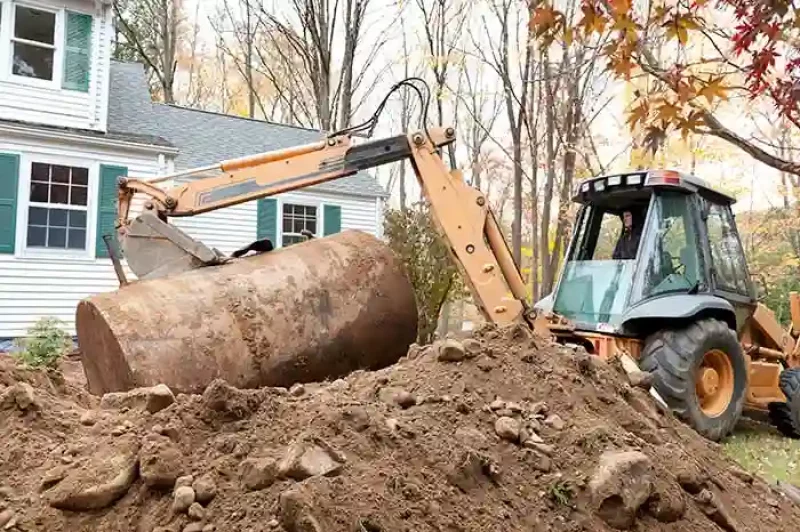Beneath the surface of many residential properties lies a hidden concern – aging or obsolete oil tanks. “Beneath the Earth: Strategies for Safe Residential Oil Tank Removal” serves as a comprehensive guide for homeowners grappling with the necessity of removing these buried relics. From understanding the signs of an aging tank to implementing safe removal strategies, this guide is designed to illuminate the path to a secure and environmentally responsible oil tank removal.
Recognizing the Buried Challenge: Signs of Aging Tanks
The journey begins with homeowners recognizing the buried challenge beneath the earth – aging oil tanks. Signs of rust, corrosion, and potential leaks are key indicators that prompt homeowners to consider the necessity of removal. Understanding these signs is essential for a proactive approach to addressing potential hazards and ensuring the safety of the property.
Environmental Preparedness: Minimizing Impact in the Removal Process
Environmental consciousness takes center stage in safe residential oil tank removal. Homeowners need to assess and minimize the potential impact on the surrounding environment, including soil and groundwater. This section of the guide emphasizes responsible practices to mitigate environmental consequences during the oil tank removal process.
Navigating the Regulatory Landscape: Securing Permits for Compliance
Successfully navigating the regulatory landscape is a crucial step in safe oil tank removal. Homeowners must secure the necessary permits and adhere to local regulations governing the removal process. Compliance ensures not only the legality of the removal but also streamlines the process, avoiding potential delays and penalties.
Professional Collaboration: Consulting Removal Experts
Collaborating with removal experts is a key aspect of safe residential oil tank removal. Removal professionals bring specialized knowledge about tank conditions, potential risks, and optimal removal methods. This collaboration ensures that homeowners make informed decisions, contributing to a safe and efficient oil tank removal process.
Risk Assessment: Identifying and Mitigating Hazards Below Ground
Conducting a thorough risk assessment is pivotal for a safe residential oil tank removal. Identifying potential hazards, whether structural or environmental, empowers homeowners to implement targeted mitigation strategies. A comprehensive risk assessment minimizes the likelihood of accidents and ensures a safe and successful oil tank removal operation.
Choosing the Right Removal Method: Tailoring to Below-Ground Dynamics
Selecting the appropriate removal method is a critical decision in the safe removal of buried oil tanks. Factors such as the tank’s condition, location, and potential environmental impact guide this choice. Tailoring the removal method to below-ground dynamics ensures an efficient and safe operation, minimizing disruption and mitigating potential risks associated with the removal process
Strategic Excavation: Precision in Uncovering the Buried Tank
Safe residential oil tank removal requires strategic excavation below the earth’s surface. Skilled operators, armed with specialized tools, must execute precise digging techniques to uncover and extract the tank without causing damage or environmental disruption. Precision in excavation is vital for the success of the oil tank removal process.
Pumping Protocols: Safely Extracting Contents from Below Ground
Strategic pumping protocols are crucial for safely extracting the tank’s contents from below ground. Advanced pumping technologies minimize the risk of spills, ensuring a controlled and clean extraction process. Adhering to environmental regulations guarantees the responsible handling and disposal of extracted oil, aligning with the emphasis on safety and efficiency.
Tactical Lifting and Transport: Ensuring a Secure Transition Above Ground
Tactical lifting and transport are pivotal elements explored in safe oil tank removal from below ground. Precision and specialized equipment ensure a secure extraction without causing damage. Skilled operators contribute to a safe removal process, minimizing risks associated with lifting and transporting the tank from below ground to above ground, ensuring a secure transition.
Post-Removal Verification: Confirming Success and Environmental Integrity
The process concludes with post-removal verification, a critical step highlighted in the guide. Environmental testing and soil analysis provide assurance that the removal process has been safe and effective, leaving the property free from contamination. Confirming success ensures homeowners can move forward confidently, having safely navigated the process of residential oil tank removal from below the earth’s surface.
Conclusion:
“Beneath the Earth: Strategies for Safe Residential Oil Tank Removal” provides homeowners with a comprehensive guide for navigating the complexities of removing buried oil tanks. From recognizing signs of aging tanks and preparing for potential environmental impact to navigating regulations, consulting with professionals, and implementing safe removal methods, this guide ensures a smooth and responsible oil tank removal process. Risk assessments, strategic excavation, pumping protocols, tactical lifting, and post-removal verification contribute to the safety and success of the oil tank removal, allowing homeowners to confidently address the buried challenge beneath their properties.

